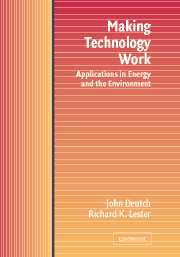Book contents
- Frontmatter
- Contents
- Preface
- 1 Introduction
- 2 Gasohol
- 3 Solar Thermal, Windpower, and Photovoltaic Technologies
- 4 Electricity from Coal
- 5 Controlling Acid Rain from Coal-fired Power Plants
- 6 Greenhouse Gases and Global Warming
- 7 Nuclear Power and Its Fuel Cycle
- 8 Managing Nuclear Waste
- 9 Nuclear Power and Weapons Proliferation
- 10 Natural Gas
- 11 Safety and Risk: Examples from the Liquefied Natural Gas and Nuclear Industries
- 12 Synthetic Fuels
- 13 Fuel Cells For Automobiles
- 14 Energy Models and Statistics
- 15 The Government's Role in Innovation
- 16 Conclusions
- Index
15 - The Government's Role in Innovation
Published online by Cambridge University Press: 10 December 2009
- Frontmatter
- Contents
- Preface
- 1 Introduction
- 2 Gasohol
- 3 Solar Thermal, Windpower, and Photovoltaic Technologies
- 4 Electricity from Coal
- 5 Controlling Acid Rain from Coal-fired Power Plants
- 6 Greenhouse Gases and Global Warming
- 7 Nuclear Power and Its Fuel Cycle
- 8 Managing Nuclear Waste
- 9 Nuclear Power and Weapons Proliferation
- 10 Natural Gas
- 11 Safety and Risk: Examples from the Liquefied Natural Gas and Nuclear Industries
- 12 Synthetic Fuels
- 13 Fuel Cells For Automobiles
- 14 Energy Models and Statistics
- 15 The Government's Role in Innovation
- 16 Conclusions
- Index
Summary
The fundamental purpose of national government is to protect and improve the public welfare. Governments seek to defend national security (in the broadest sense), work to improve the economic well-being of their citizens, and protect public health, safety, and natural resources. Technological advance plays a vital role in each of these domains. The government, therefore, has a strong interest in encouraging technological innovation. But exactly what should this role be? How can the government be involved most effectively in the development and implementation of new technologies? What policy instruments can and should the government use to intervene in the innovation process?
The pace and direction of innovation depends on the research and development (R&D) activity of the economy. As Figure 15.1 shows, each year U.S. industry and government both devote large amounts of resources to R&D.
The R&D activity reported in these statistics is only part of the innovation process, of course. As we have seen, inventing and developing technology is just one of the steps involved. Invention must be followed by implementation, which is a complex, uncertain, and costly process. Our focus in this chapter is primarily on R&D, especially the R&D that is funded by the U.S. government at a current rate of roughly $75 billion per year. By any measure, this is a lot of money. But is it too much? Or not enough?
- Type
- Chapter
- Information
- Making Technology WorkApplications in Energy and the Environment, pp. 246 - 262Publisher: Cambridge University PressPrint publication year: 2003

